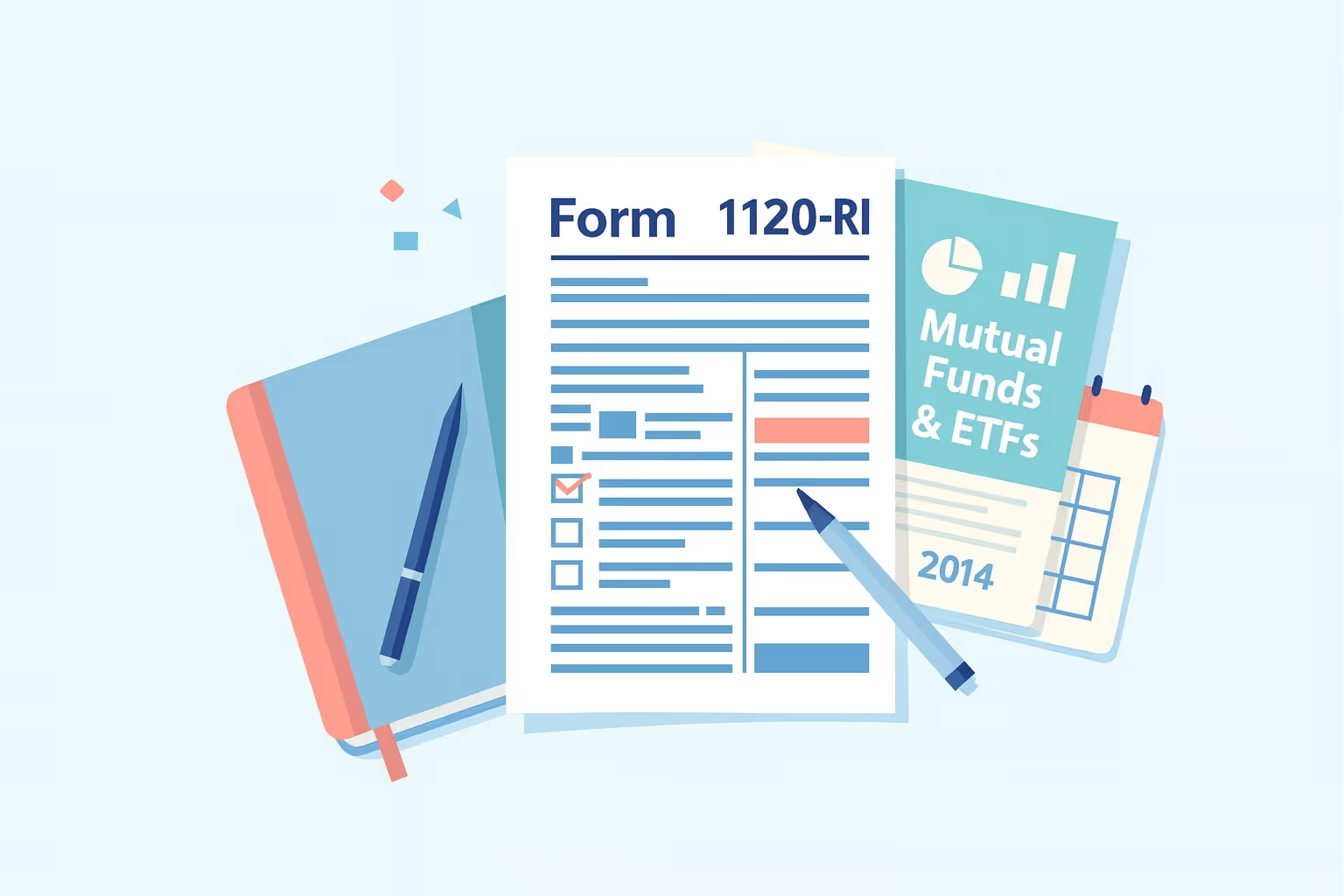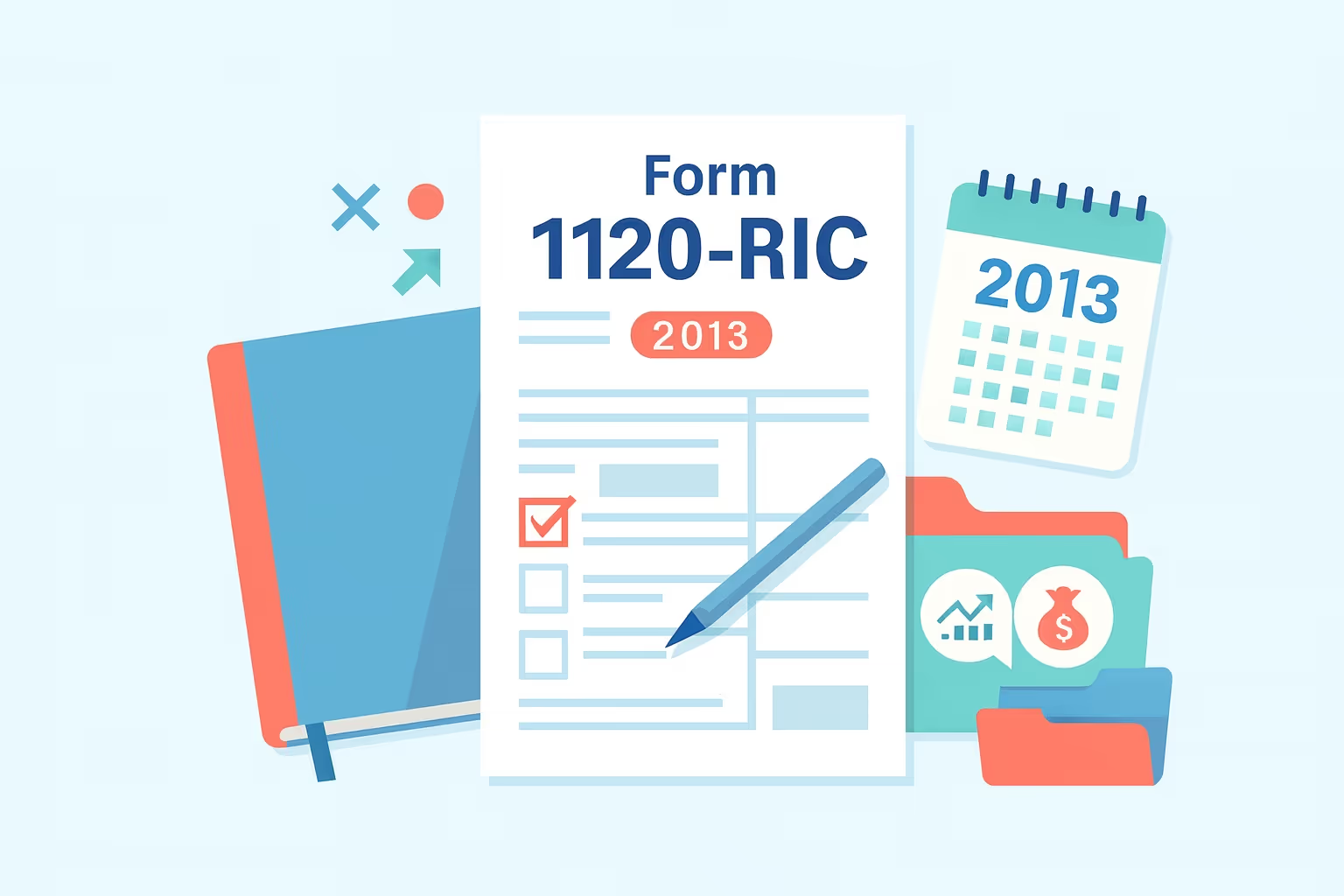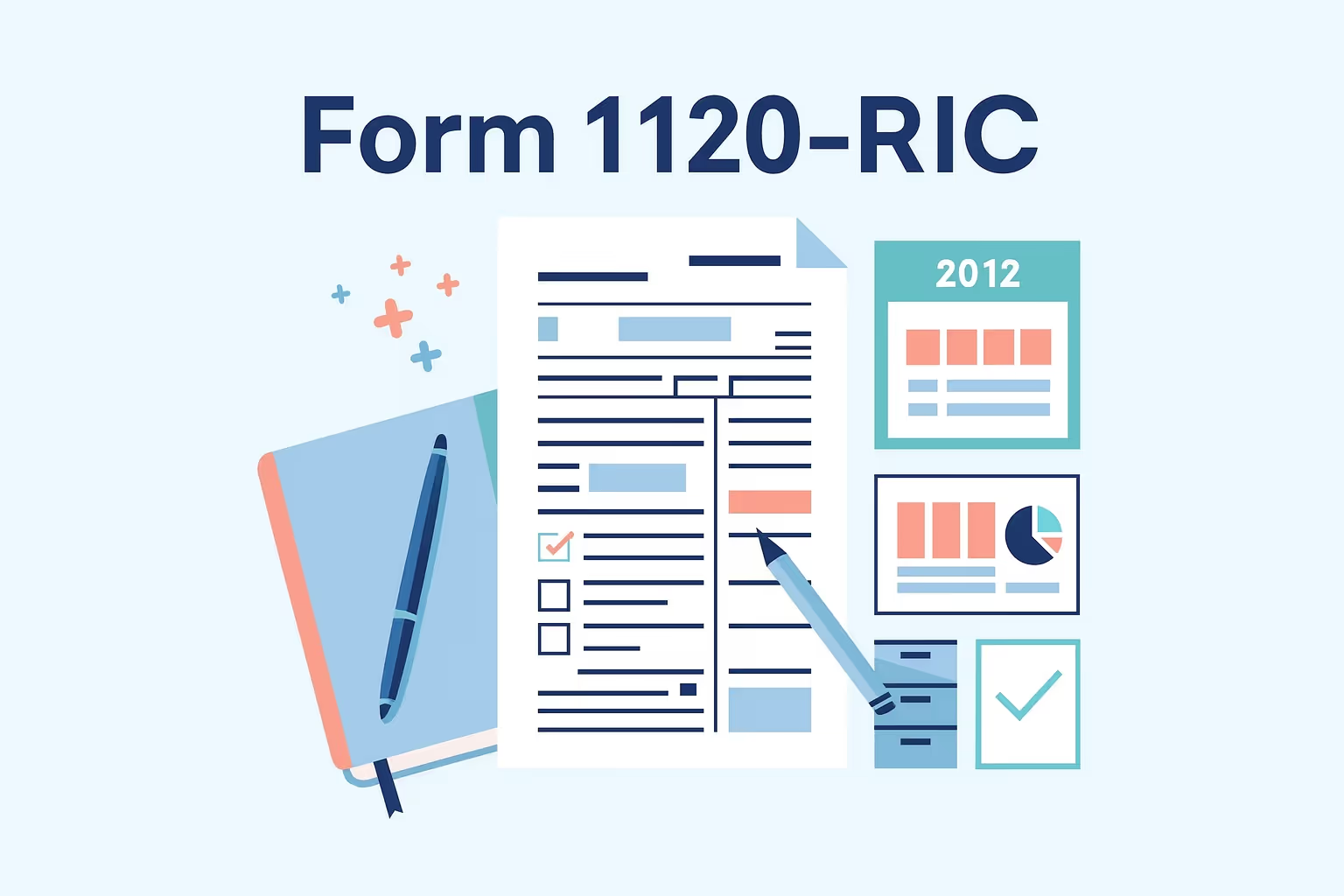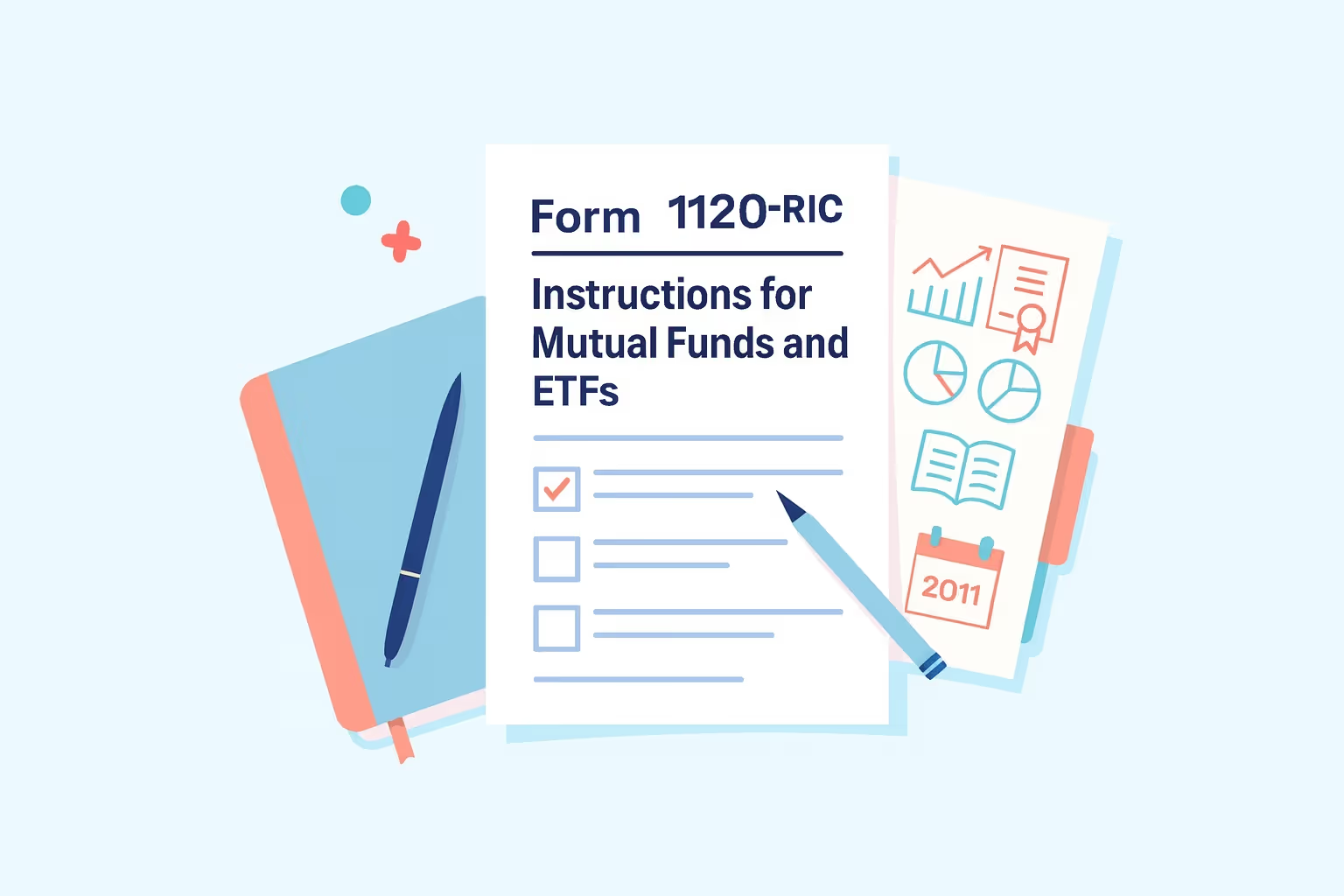Form 1120-RIC 2018 Instructions: Step-by-Step Guide
Form 1120-RIC is the income tax return used by regulated investment companies to report income, deductions, and distributions to the Internal Revenue Service for a specific tax year. These companies include mutual funds, exchange-traded funds, and other entities that qualify for special tax treatment under the Investment Company Act of 1940. Filing this form allows a domestic corporation to be treated as a regulated investment company, enabling it to pass most of its taxable income directly to shareholders and avoid double taxation.
For the 2018 tax year, significant changes introduced by the Tax Cuts and Jobs Act affected how RICs calculate their federal income tax. The new law established a flat 21% corporate tax rate and eliminated the corporate alternative minimum tax. These adjustments simplified the tax computation process but also introduced new reporting requirements related to business interest deductions, GILTI inclusions, and foreign income transitions. Understanding these updates is essential for maintaining compliance with the Internal Revenue Service.
This guide provides Form 1120-RIC 2018 instructions in a step-by-step format to help taxpayers complete the filing process accurately and efficiently. It explains how to calculate investment company taxable income, apply deductions, determine tax liability, and meet federal return deadlines. Designed for clarity and accessibility, it helps regulated investment companies meet their filing obligations while minimizing errors and penalties.
Understanding Form 1120-RIC and RIC Qualification
Form 1120-RIC is the income tax return that regulated investment companies use to report taxable income, deductions, and credits to the Internal Revenue Service. It is explicitly designed for entities such as mutual funds and exchange-traded funds that qualify as regulated investment companies under federal tax law. Filing this form also serves as an election to be treated as a RIC, allowing the company to distribute most of its income to shareholders and reduce the risk of double taxation.
Key Qualification Requirements
To be recognized as a regulated investment company, a corporation must meet three main tests throughout the tax year.
- Income Test
At least 90 percent of the company’s gross income must come from qualifying sources, including dividends, interest, and gains from the sale of securities. This ensures that the company primarily earns investment-related income rather than income from unrelated business activities. - Asset Test
The company must meet diversification standards at the end of each quarter. At least 50 percent of total assets must consist of cash, government securities, or other RICs, with limits on the amount that may be invested in any single issuer. This requirement prevents excessive concentration of risk. - Distribution Test
The company must distribute at least 90 percent of its investment company taxable income to shareholders. Distributions can include ordinary dividends and capital gain dividends. Meeting this requirement helps maintain RIC status and minimizes corporate-level tax liability.
Benefits of RIC Qualification
Filing Form 1120-RIC provides significant tax advantages. It allows regulated investment companies to avoid corporate-level federal income tax on distributed income, instead supporting shareholder-level taxation. Maintaining compliance with qualification tests ensures ongoing eligibility for these benefits and consistent treatment under Internal Revenue Service regulations.
What’s New for Tax Year 2018?
The Tax Cuts and Jobs Act introduced several major updates that changed how regulated investment companies calculate and report their federal income tax for 2018. Understanding these updates is essential for maintaining compliance and ensuring accurate tax reporting.
Key Changes for RICs
- The corporate tax rate was reduced to a flat 21 percent for all corporations, replacing the prior graduated rate system.
- The corporate alternative minimum tax was repealed, simplifying the calculation of tax liability.
- Certain RICs that are U.S. shareholders of controlled foreign corporations must now include Global Intangible Low-Taxed Income (GILTI) in gross income, reported on Form 8992.
- Section 163(j) introduced new limits on business interest expense deductions, generally restricting them to 30 percent of adjusted taxable income.
- Section 965 established transition rules for the taxation of deferred foreign income, requiring inclusion of certain previously untaxed earnings.
- New reporting obligations and forms were added to align with changes in international and domestic tax law.
These revisions simplified some filing requirements while introducing new compliance challenges. RICs must review all 2018 instructions and related tax forms carefully to ensure they meet eligibility requirements and report income accurately.
Step-by-Step Instructions for Completing Form 1120-RIC
Completing Form 1120-RIC correctly is critical to ensure that a company’s investment income, deductions, and distributions are accurately reported to the Internal Revenue Service. The following steps outline the proper filing process.
Step 1 – Gather Required Information.
Before filling out the form, the company should prepare all relevant documents:
- Gather financial statements and accounting records that support all reported figures.
- Compile dividend payment records and shareholder distribution schedules.
- Include Form 1099 and any foreign tax credit documentation if applicable.
- Review the prior-year income tax return for reference and comparison.
Step 2 – Complete Income and Deduction Sections.
- Report all types of income, including dividends, interest, and capital gains.
- Enter allowable deductions, such as management fees, administrative expenses, and other operational costs.
- Calculate the investment company's taxable income before applying any dividends paid deduction.
Step 3 – Calculate the Dividends Paid Deduction.
- Use Schedule A to determine the total dividends paid deduction.
- Include both ordinary and capital gain dividends when applicable.
- Confirm that at least 90 percent of taxable income is distributed to maintain RIC qualification.
Step 4 – Determine Tax Liability.
- Use Schedule J to calculate tax liability based on the flat 21 percent rate.
- Include additional taxes, such as excise tax, if required.
- Consider applicable tax credits and estimated tax payments when determining the final balance due.
Step 5 – Verify Required Schedules.
- Ensure that all applicable schedules are completed and attached to this document.
- Cross-check totals to confirm accuracy and consistency between forms.
- Keep copies of all documents and supporting calculations for recordkeeping and future reference.
Properly completing Form 1120-RIC reduces the risk of errors, penalties, or delays in processing by the Internal Revenue Service.
How to File Form 1120-RIC (E-File and Paper Filing)?
Regulated investment companies may file their income tax return electronically or by mail. The Internal Revenue Service encourages electronic filing for accuracy and faster processing.
Electronic Filing
- Use IRS-approved e-filing software to complete and transmit the return.
- Verify that all schedules and attachments are included in the electronic file.
- Ensure the form is digitally signed by an authorized corporate officer.
- Retain an electronic copy of the filed return for company records.
Paper Filing
- Mail the completed return to the appropriate IRS processing center, which is determined by your total assets and state location.
- For companies with assets under $10 million, send the return to the Kansas City, Missouri, processing center.
- Use certified mail or a delivery service that provides proof of delivery.
- Keep copies of mailing receipts and tracking information for future reference and confirmation.
Filing Deadlines and Extensions
- The return is generally due on the fifteenth day of the fourth month after the end of the tax year.
- Companies with a fiscal year ending June 30 must file by the fifteenth day of the third month following the end of the year.
- Use Form 7004 to request an automatic six-month filing extension if additional preparation time is needed.
- Extensions apply only to the filing, not to the payment of tax owed.
Filing electronically or on paper requires attention to detail and proper documentation to avoid processing delays and maintain compliance with federal tax requirements.
Payment and EFTPS Requirements
All regulated investment companies are required to make their federal tax payments electronically through the Electronic Federal Tax Payment System (EFTPS). Using EFTPS ensures secure, timely transactions, confirming payment for accurate recordkeeping.
Electronic Payment Rules
- All corporations, including regulated investment companies, are required to use electronic funds transfer for federal tax deposits.
- Payments must be scheduled by 8 p.m. Eastern Time on the day preceding the due date to be considered timely.
- The company must register for an EFTPS account in advance and verify its bank account details before making payments.
- Confirmation numbers should be saved as proof of payment and maintained with tax records.
Estimated Tax Payments
- Estimated tax payments are required if the company expects to owe $500 or more in federal income tax for the year.
- Payments are generally made in four equal installments during the tax year.
- Each installment is due on the fifteenth day of the fourth, sixth, ninth, and twelfth months of the company’s tax year.
- Companies can calculate their installments using Form 1120-W as a worksheet to avoid underpayment penalties.
Payment Penalties
- A late payment penalty of 0.5% per month may apply to any outstanding balance.
- Interest accrues from the original due date until the payment is made in full.
- Underpayment of estimated taxes may result in additional penalties under IRS rules.
Complying with EFTPS payment requirements ensures timely remittance of taxes and reduces the risk of penalties or interest charges.
Common Mistakes and How to Avoid Them
Filing Form 1120-RIC involves detailed financial reporting, and even minor errors can result in penalties or the loss of RIC status. Understanding common mistakes helps companies ensure accurate and compliant filings.
Frequent Errors
- Failing to meet RIC qualification requirements by not distributing at least 90 percent of the investment company's taxable income to shareholders.
- Misreporting income or deductions due to incomplete financial records or incorrect data entry.
- Omitting required schedules, such as Schedule A for dividends paid or Schedule L for balance sheets.
- Using the incorrect tax rate or forgetting to apply the flat 21 percent corporate rate for the 2018 tax year.
- Submitting late EFTPS payments or using incorrect payment codes.
- Leaving required questions on Schedule K unanswered or failing to include supporting statements.
Prevention Tips
- Conduct quarterly reviews of income and asset tests to maintain RIC qualification.
- Use tax preparation software with validation tools to identify missing information or calculation errors.
- Double-check dividend deductions and reconcile financial statements before filing.
- Keep detailed documentation of income, expenses, and distributions in case of IRS review.
- Work with tax professionals familiar with investment company tax law to verify compliance.
By identifying and correcting potential issues before filing, companies can minimize errors and maintain good standing with the Internal Revenue Service.
Special Situations: Zero Activity and First-Time Filers
Some regulated investment companies may have minimal or no activity during the year, while others may be filing Form 1120-RIC for the first time. Both situations require careful handling to ensure compliance and proper recordkeeping.
Zero-Activity or Dormant RICs
- A RIC must still file Form 1120-RIC if it has total assets, shareholders, or distributions during the tax year, even if no income was earned.
- When filing with no activity, income and deduction lines should be completed with zeros, and the return should be signed and dated.
- Filing maintains the RIC election and ensures continued recognition by the Internal Revenue Service for future years.
- If the company has no assets, income, or expenses, and plans to terminate its status, it should file a final return and check the appropriate box.
First-Time Filers
- Filing Form 1120-RIC for the first time serves as the official election to be treated as a regulated investment company.
- Before filing, the company must confirm that it meets the income, asset, and distribution tests required by law.
- The company should establish reliable systems for recordkeeping, dividend tracking, and quarterly compliance testing.
- New filers should review the IRS instructions thoroughly or consult a tax professional to ensure a complete understanding of the reporting requirements.
Addressing these exceptional cases helps maintain regulatory compliance and prepares companies for smoother filing in subsequent tax years.
RIC Distribution and Excise Tax Rules
Regulated investment companies must follow specific distribution and excise tax rules to maintain their tax-advantaged status and avoid additional federal tax liability. Meeting these requirements ensures that most taxable income is passed through to shareholders rather than taxed at the corporate level.
Distribution Requirements
- A RIC must distribute at least 90 percent of its investment company taxable income to shareholders during the tax year.
- Qualifying distributions include ordinary dividends, capital gain dividends, and exempt-interest dividends.
- Distributions may be made after year-end if completed before the return’s due date and elected adequately on the tax form.
- Accurate documentation of dividend payments is required to support the deduction for dividends paid.
Excise Tax Rules
- RICs may be subject to a 4 percent excise tax on undistributed income under Section 4982 of the Internal Revenue Code.
- The excise tax applies to undistributed ordinary income and capital gains that were not distributed within the required time frame.
- To avoid the excise tax, a RIC must distribute 98 percent of its ordinary income and 98.2 percent of its capital gains for the calendar year.
- Proper planning and recordkeeping help ensure compliance and minimize the risk of paying additional taxes.
Following these distribution and excise tax rules helps maintain RIC qualification and reduces the likelihood of corporate-level taxation.
Maintaining Compliance and Recordkeeping Best Practices
Substantial compliance and effective recordkeeping systems are essential for accurate tax reporting and for maintaining RIC status. Consistent documentation supports the company’s ability to substantiate its income, deductions, and shareholder distributions.
Recordkeeping Essentials
- Maintain detailed accounting records that include income, expenses, and distribution data.
- Store copies of all filed forms, including Form 1120-RIC, schedules, and attachments.
- Retain records of quarterly RIC qualification tests, including documentation for income and asset diversification.
- Keep all shareholder communication records related to dividends, capital gains, and tax statements, including any correspondence, documents, and other relevant materials.
Compliance Practices
- Conduct quarterly reviews to confirm that income and asset tests are met throughout the year.
- Reconcile book and tax records regularly to identify and correct discrepancies early.
- Stay updated on changes in federal tax law that affect RIC filing requirements.
- Engage tax professionals to review returns and verify that all filing and payment obligations are met.
Maintaining accurate documentation and proactive compliance practices supports consistent reporting accuracy and protects the company’s standing with the Internal Revenue Service.
Frequently Asked Questions
What is Form 1120-RIC, and how does it apply to regulated investment companies?
Form 1120-RIC is the official income tax return used by regulated investment companies to report taxable income, deductions, and distributions to the Internal Revenue Service. It applies to mutual funds, exchange-traded funds, and certain real estate investment trusts that qualify for RIC status under the Internal Revenue Code. Filing this tax form allows a domestic corporation to avoid double taxation and correctly calculate its federal income tax for each tax year.
How do regulated investment companies calculate investment company taxable income?
Regulated investment companies determine investment company taxable income by subtracting deductible expenses from gross income, which includes dividends, capital gains, and interest. Adjustments may be made for items such as foreign tax credits, special deductions, or net capital losses. Accurate reporting on Form 1120-RIC ensures compliance with Internal Revenue Service regulations and helps determine the company’s overall tax liability and effective tax rate for the federal return.
When is Form 1120-RIC due, and what are the electronic filing options?
Form 1120-RIC must be filed by the fifteenth day of the fourth month after the end of the company’s tax year. Companies using a calendar year basis must file by April 15. The Internal Revenue Service strongly encourages electronic filing for faster processing. E-filing enables the secure submission of income tax returns, supporting forms, and estimated tax payments through approved IRS systems, facilitating easier tracking and confirmation.
How can regulated investment companies reduce their federal income tax?
A company may minimize its federal income tax by distributing at least 90 percent of its investment company taxable income to shareholders during the tax year. These payments, which include dividends and capital gain distributions, qualify for deductions that reduce overall tax liability. Regulated investment companies may also claim tax credits, apply special deductions, and manage capital gains in line with the latest tax laws to maintain compliance and maximize savings.
What happens if a regulated investment company fails to qualify under IRS rules?
If a regulated investment company fails to meet qualification tests, such as income or asset diversification requirements, it will be taxed as a standard domestic corporation. This means its income will face double taxation—first at the corporate level and again when distributed to shareholders. The company’s net income, tax rates, and eligibility for special deductions will be affected, potentially increasing the overall tax bill on its federal return.
How can RICs manage estimated tax payments and refund information?
Regulated investment companies must make estimated tax payments if they expect to owe money exceeding $500 in federal income tax for the tax year. Payments are made through the Electronic Federal Tax Payment System and can be tracked using an IRS income tax calculator. Overpayments may result in a tax refund, which can be received via direct deposit. Tax professionals recommend reviewing refund status and refund information regularly to plan for financial goals.


























